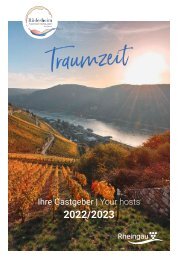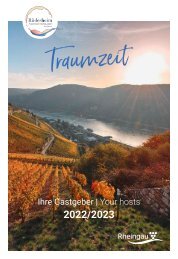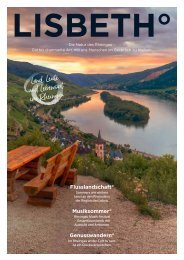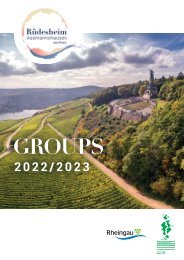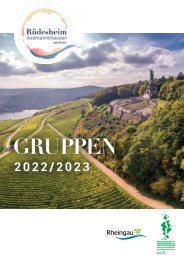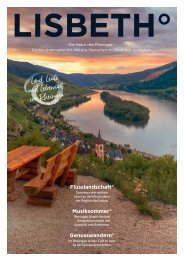Sie wollen auch ein ePaper? Erhöhen Sie die Reichweite Ihrer Titel.
YUMPU macht aus Druck-PDFs automatisch weboptimierte ePaper, die Google liebt.
Bodenschatz: Schiefer bildet mineralische
Noten im Terroir der Rheingau-Weine
these benefit from the cool downslope wind from the
Taunus, which ensures freshness and an extended
ripening period – perfect for the late ripening varieties
Riesling and Pinot noir!
Provenance you can taste: thanks to the unique terroir,
you can taste the Rheingau provenance. The interplay
of soil, climate and topography creates individuality and
autonomy. The soils, too, play a key role. They consist
of Taunus quartzite, clay, loam and loess. Quartzite and
shale give elegant, mineral notes, while loam and loess
bring out the robustness of full-bodied wines. ■
Des Dichterfürsts Lieblingsaussicht auf den Rhein –
der nach ihm benannte „Goetheblick“ vom Johannisberg
Denkmal des „Spätlesereiters“
bei Schloss Johannisberg.
Die Figur verweist auf die „Entdeckung“
der Spätlese anno 1775.
Taunusquarzit, Ton, Lehm und Löss. Quarzit und Schiefer bilden
elegante und mineralische Noten. Löss und Lehm wiederum bringen
einen vollmundigen Wein mit kräftigem Körper hervor. ■
Small region, great wines
With approximately 3,200 ha, the Rheingau ranks eighth out
of Germany’s 13 wine-growing regions. At the same time, it is a
byword for Riesling – the main player in the Rheingau with 80%
of the vineyards. Pinot noir (Spätburgunder) follows in second
place with 12 percent of the area under culti vation. The Rheingau
is also the birthplace of the Spätlese: the Castle of Johannisberg.
This is why excellent Spätlese Rieslings crown the Rheingau wines.
No matter where they originate: the Rheingau winegrowers
create exceptional wines full of personality which characterise
the attitude to life in their homeland and act as ambassadors
throughout the world.
What effect does climate have on wine? At the Rhine’s knee near
Wiesbaden, the Rhine makes its only change of direction on its
way to the North Sea. As a result, the best Rheingau locations
face south south-west and thrive in a well-balanced “cool climate”.
Due to the southern orientation, the wines enjoy maximum
sun. The Rheingau is protected from the rain by the Taunus
mountains to the north. For one thing, the intensive sunshine
reliably contributes to the ripening of the grapes. For another,
21 | lisbeth°






